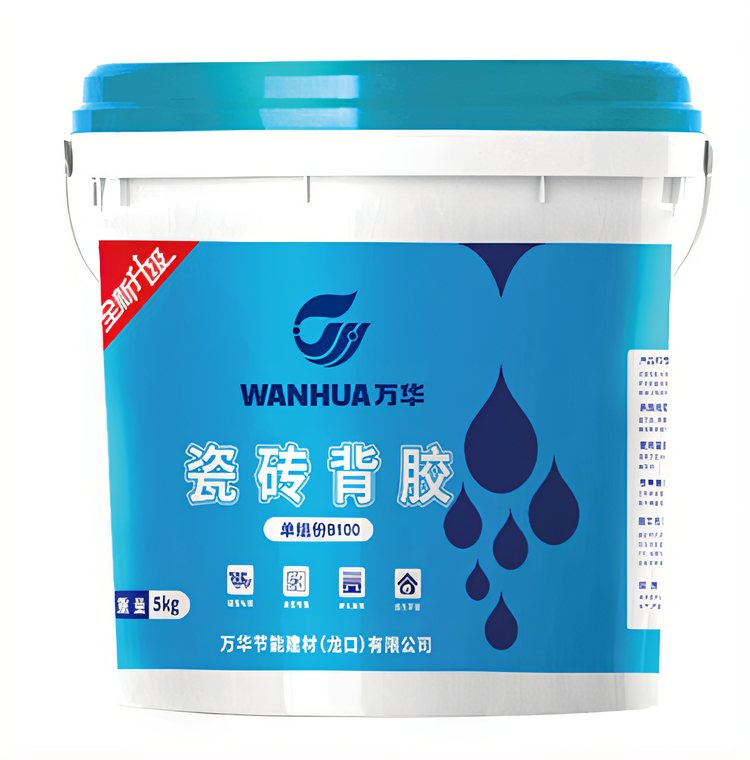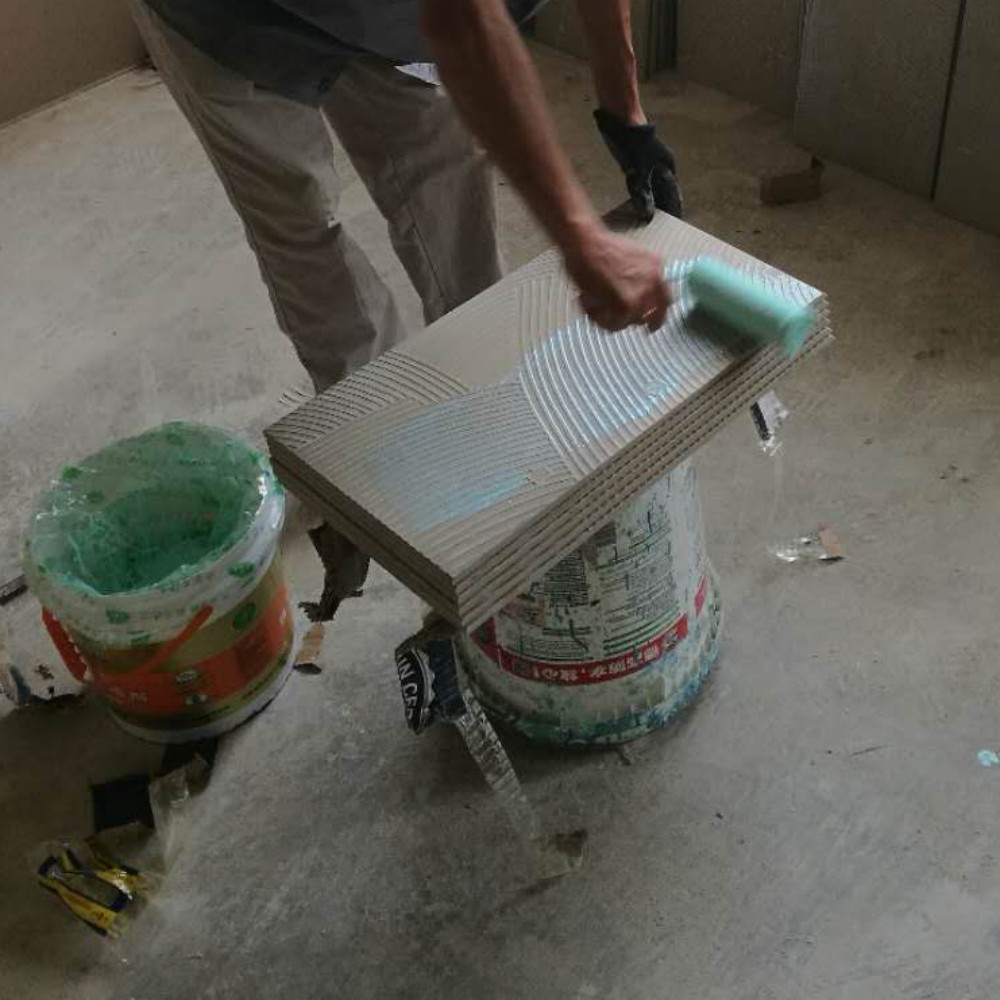

During the ceramic tile installation process, the presence of an oil film on the back of the tiles often becomes a key hidden danger affecting the installation quality. If not properly handled, it may lead to insufficient bonding force between the tiles and the adhesive, thereby causing problems such as hollowing and falling off of the tiles. Therefore, it is crucial to master scientific oil film treatment methods and appropriate adhesive selection techniques.
1. Types and Characteristics of Ceramic Tile Back Adhesives
Currently, ceramic tile back adhesives on the market are mainly divided into three categories. Different types of back adhesives have significant differences in composition, application scenarios, and performance, and construction personnel need to select them reasonably according to specific needs:
- Two-component ceramic tile back adhesive: It is used by mixing two components, usually including resin, curing agent, etc., and must be used up within a specified time after mixing. Its advantages are high bonding strength, good durability, and better water resistance and UV resistance than single-component products. It is suitable for occasions with high requirements for bonding performance, such as outdoor walls, bathrooms, kitchens, and other humid areas for tile installation. However, the two-component back adhesive requires precise control of the proportion of the two components during use, and the mixing process is relatively cumbersome, which has certain requirements for the professionalism of construction operations.
- Single-component ceramic tile back adhesive: It can be directly brushed and used without additional preparation after opening the bucket, which is convenient and efficient to operate, and can greatly shorten the construction time. Therefore, it is favored by the majority of construction workers. However, the single-component back adhesive is an organic material. During long-term use, its durability, water resistance, and UV resistance are significantly insufficient compared with cement-based products. Based on this characteristic, the single-component back adhesive is more suitable for indoor use, and it is strongly recommended to use it only in dry areas (such as dry walls in living rooms and bedrooms). If used in humid or outdoor environments, not only will the use effect be greatly reduced, but also serious safety hazards such as tile falling off may occur.
- Paste-like ceramic tile back adhesive: It has a paste-like texture, good sealing and filling properties, and can closely fit the back of the tile and the base layer, effectively reducing air residue and improving bonding stability. This type of back adhesive performs well when installing some tiles with uneven surfaces or small gaps. It can fill the tiny depressions on the back of the tiles through its paste-like characteristics and increase the contact area with the adhesive. However, the drying speed of the paste-like ceramic tile back adhesive is relatively slow. During construction, it is necessary to pay attention to controlling the brushing thickness and curing time to avoid affecting the bonding effect due to insufficient drying.
In terms of functional essence, the ceramic tile back adhesive is a special adhesive directly applied to the back of the ceramic tile, and also an interface agent that can enhance the double-sided bonding ability. By changing the physical properties (such as surface roughness, pore structure) and chemical characteristics (such as intermolecular forces, chemical bonds) of the back of the tile and the surface of the adhesive, it builds a solid "bridge" between the tile and the adhesive, thereby greatly improving the bonding force between the tile and the base layer. It is especially suitable for construction occasions with certain bonding difficulties, such as tiles with low water absorption and smooth surfaces (such as full-glazed tiles, marble tiles), and effectively solves the problem that tiles are difficult to bond firmly in traditional installation methods.
2. Sources of the Oil Film on the Back of Ceramic Tiles
The formation of the oil film on the back of ceramic tiles is not due to a single reason, but is caused by the combined action of multiple factors, which can be mainly summarized into the following three sources:
- Exogenous pollution: During the production, processing, transportation, and storage of ceramic tiles, the base surface on their back is easily contaminated by external oil stains. For example, during the production process, if the equipment lubricating oil leaks, it may adhere to the back of the tiles; during transportation, if the tiles are stored together with oily substances such as diesel oil and asphalt, these substances may contaminate the tiles due to packaging damage; during storage at the construction site, if they accidentally come into contact with daily oil stains such as edible oil, an oil film will also form on the back of the tiles. The composition of such exogenous oil stains is complex, and if not cleaned properly, it will seriously prevent the back adhesive from contacting the back of the tiles and affect the bonding effect.
- Transfer pollution from protective wax: In order to protect the front surface of the tiles from scratches and wear during transportation and storage, some ceramic tile manufacturers will apply a layer of temporary protective wax on the front surface of the tiles, most of which are water-based waxes, but some brick factories also use oil-based waxes. During the processing, handling, or stacking of the tiles, if the operation is improper (such as excessive pressure during tile stacking, dust particles on the surface), the protective wax on the front surface may transfer to the back of the tiles, thereby forming an oil film on the back. Although this oil film is used to protect the tiles, after transferring to the back, it becomes an obstacle to the bonding of the back adhesive.
- Residual release agent from production: During the production of ceramic tiles, in order to facilitate the smooth separation of the tiles from the production mold and avoid bonding between the tiles and the mold leading to forming defects, manufacturers will apply a release agent on the surface of the mold or the tile blank. The release agent usually has a certain oiliness. If it is not thoroughly cleaned in the subsequent cleaning process, it will remain on the back of the tiles and form an oil film. This residual release agent will form a smooth isolation layer on the back of the tiles, directly preventing the effective bonding between the ceramic tile back adhesive and the tile itself, and is a common cause of hollowing and falling off of the tiles after installation.
It should be noted that not all tile backs will have problems caused by the oil film. Generally speaking, the back of extremely dense or smooth tiles (such as tiles made by some special processes) will not have shrinkage holes. Even glass materials with zero water absorption will not have shrinkage holes on their surfaces. This is because the surface structure of such materials is dense, making it difficult for oil stains to penetrate and adhere, and it is not easy to form pore structures that affect bonding. However, in actual installation, it is still necessary to select appropriate back adhesives and treatment methods according to specific materials.
3. Treatment Method for the Oil Film on the Back of Ceramic Tiles
The treatment of the oil film on the back of ceramic tiles does not require complex equipment or tedious processes, and the method is simple and efficient. The specific operation steps are as follows:
- Material preparation: Select alkaline powder materials containing cement components, such as cement dry powder, joint filler dry powder, or ceramic tile adhesive dry powder. The alkaline components in these materials can chemically react with the oil film to effectively decompose the oil stains. At the same time, the cement components can form a good combination with the back adhesive and the base layer in the subsequent installation, without causing additional impact on the tile bonding. Moreover, these materials are easily available at the construction site and have low costs.
- Wiping treatment: Sprinkle the prepared alkaline powder evenly on the oil film area on the back of the tile, then gently wipe it with a clean cloth or sponge. During the wiping process, the alkaline powder will fully contact the oil film, decompose the oil stains through chemical action, and the physical wiping action can remove the residual decomposed oil stains from the back of the tile. It should be noted that the wiping force should be moderate to avoid scratching the back of the tile due to excessive force, which may affect the subsequent brushing and bonding of the back adhesive.
- Rinsing with clean water: After wiping, thoroughly rinse the back of the tile with clean water. The purpose of rinsing is to completely remove the residual alkaline powder and decomposed oil stains on the back of the tile, preventing the residual substances from affecting the bonding performance between the back adhesive and the back of the tile. During rinsing, a sponge or soft cloth can be used to assist in wiping to ensure that there are no residues on the back of the tile. After rinsing, place the tile in a ventilated and dry place to dry. After the back of the tile is completely dry, the back adhesive can be brushed and the subsequent installation construction can be carried out.
The above knowledge about the treatment of the oil film on the back of ceramic tiles and related back adhesives is provided by a professional Shandong ceramic tile adhesive manufacturer. If you encounter more problems during the actual construction process, you can pay attention to the manufacturer's website to obtain more professional construction guidance and technical support.

